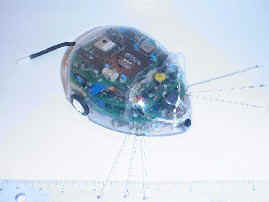Maelzel
Detailed Host Information
The robot's chassis, made by Tamiya, Inc., provides the agent with a vehicular host. As the agent's vehicular host the chassis, and its enhancements, provide the agent with a limited set of simulated heuristics and behavioral basal phenocopy based loosely on a generalized, prototype rodent. That set includes crude haptic and olfactory exteroceptive sensation, an innate capacity to monitor the instantaneous state of host nutritional homeostasis, and an expansive set of motor behaviors.
The robotic host, an artificial rodent, has a tricycle-type dual DC motor locomotion system, uses a Radio Frequency (RF) Radio Signal Strength Indicator (RSSI) to provide simulated olfactory exteroception, and mechanical displacement haptic inputs. The robotic host continuously signals the relative magnitude of its simulated nutritional homeostasis (the actual onboard NiCad battery voltage level) and a pair of bits that indicate the nutritional status as it nears either end of a preset hysterisis loop. The host vehicle also provides a single bit indicator of the instantaneous degree of olfactory stimulation.
Due to the robot's relatively small size (approximately 10 x 14 x 6 cm), complexity, and need for vehicular autonomy, an artificial ganglionic connection is maintained with a distal controller by means of a 433 MHz RF afferent uplink and a 40 KHz Infra-Red (IR) efferent downlink. Although the artificial rodent's robotic mechanisms can be completely controlled via a standard desktop PC link, experimental control comes exclusively from the P-type Turing engine in the controller and precludes the use of the PC interface for all but check-out and diagnostic functions. When controlled from a standard PC, the interface operates at 57.6 KB and is a standard RS-232 connection albeit handled over cable, RF, and IR communication links.

Host 72 KB Download